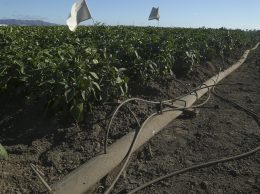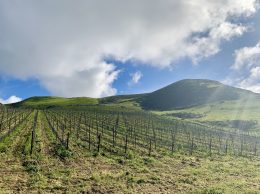Paso wine country gets drought relief with early storms
IN THIS ARTICLE
- Central Coast Topic
- Tom Bronzini Author
By Tom Bronzini Friday, January 16th, 2015
The rains that splashed over California in November and December have already been of tremendous benefit to vineyards in the Paso Robles groundwater basin, which has received a lot of attention because of the decline in its water levels.
A lot more rain is needed to restore the largest underground aquifer west of the Rockies after three years of drought. But the 6.5 inches of rain that have fallen in the Paso Robles area so far have done much to leach out an accumulation of salts in the root zones that has stressed the vines and lowered wine grape yields.
Dana Merrill, president of Mesa Vineyard Management, said yields were off 25 to 35 percent last season in the properties his company manages in the Paso Robles groundwater basin.
“I wouldn’t say it was a disaster but it definitely was on the lighter side of normal,” he said.
Among its clients, Mesa manages about 3,000 acres in Paso Robles, almost all in the groundwater basin.
The drip systems used in vineyards are water efficient, but not nearly as effective as rainwater at leaching out salts, Merrill said.
“Wine grapes are very sensitive to salts and so therefore as we got into mid part of the season, the end of the year, you start looking at the canopies and you start seeing some signs of stress,” Merrill said.
The leaves started turning a little red or yellow. Clusters were smaller. If left unchecked, salts can threaten the long-term viability of the vines, he said.
In terms of quality, the latest vintage was well received because wineries like small berries and the intense flavors that go with them, Merrill said.
“And we’re OK with it too as long as we get paid enough for the grapes to meet expenses,” he said. Pumping costs soared as wells yielded fewer gallons per minute and it took much longer to irrigate.
Don Brady, winemaker and general manager at Robert Hall Winery, which has 300 acres of estate vineyards in northeastern Paso Robles, calculated that the recent rains have bathed the root zones of vines in a lot of relief.
He said one inch of rainfall will leach salts out of an average of seven inches of soil. With 6.5 inches recorded so far, he figures the slow, soaking rains have pushed the salts down about 45 inches.
Brady said the 80 percent of the harvest that came in before a late heat spell in October was pretty amazing in quality. Grapes harvested after the heat blast were challenged, he said.
Jerry Reaugh, owner of Sereno Visa Vineyards, east of Paso Robles, said yields were down 15 to 20 percent on his 69 acres and that salt accumulations were one factor.
Kevin Willenborg, winemaker at Vina Robles, said he saw higher levels of calcium and magnesium in the soils after three years of drought.
“We didn’t see levels so high in salt toxicity that it compromised the fruit,” he said. “What I did notice generally across the vineyards is that the vines seemed to be kind of naturally balancing themselves out due to the drought conditions. They tend to not set as much fruit or as big a cluster.”
Vineyard crews helped the vines along by more aggressively thinning out shoots at the beginning of the season and dropping more fruit than usual later on. Willenborg saw yields down 15 to 20 percent for cabernet and 25 to 30 percent for syrah.
Groundwater elevations have dropped more than 70 feet since 1977 in large parts of the 790-square-mile Paso Robles groundwater basin east of the Highway 101. San Luis Obispo County supervisors adopted an emergency ordinance in 2013 that temporarily bars new irrigation and development unless it is offset by reductions elsewhere.
Some rural homeowners whose wells are relatively shallow at 200 to 300 feet have seen them go dry. Agricultural wells are much deeper, 700 to 900 feet, and closely monitored.
Merrill said growers are using less water in the basin than they did in the 1980s, but overall water demand has gone up as the population has increased. He said a lot more needs to be learned about how the basin is recharged, especially at deeper levels where groundwater moves more slowly.
Reaugh, who chairs the Paso Robles Agricultural Alliance for Groundwater Solutions, said passage of the Sustainable Groundwater Management Act last year is a paradigm change in how California looks at groundwater. The law mandates that each major groundwater basin form an agency to establish a long-term, locally based groundwater management plan.
Merrill said he hopes a water district could secure some unallocated water from Lake Nacimiento to supplement the basin in dry seasons or team with the city of Paso Robles to use some of its recycled water in a recharge program.
The west side of Paso Robles does not have a deep water basin and gets more annual rainfall, but it was far below normal last season. The harvest was early and yields seem to have varied.
Merrill said Mesa thinned crops in anticipation of a dry year and yields were down around 40 percent in the approximately 200 acres managed on the west side. Justin Winery on its blog attributed a 10 to 20 percent decline to strong winds during flowering. Jack Creek said in its newsletter that yields were average, Adelaida reported online that the drought had no effect because it severely limits irrigation, and Halter Ranch reported processing record tonnage after some newer blocks were harvested.
• Contact Tom Bronzini at tbronzini@verizon.net.











